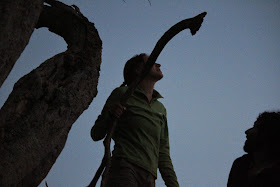Hello! My name is Molly and, as one of the new RAs, I will be spending the next year in Serena camp. Like most recent college graduates,
until now my attention span has been kept quite short by semesters and summer
jobs; I’ve never spent a whole year in one place doing one thing before! It’s become very clear, however, that field research in the Mara is not going to
get boring anytime soon!
My first night driving on obs, we
were waved down by a car and told that there was a dead hyena in a tree off the
road. When we arrived at the tree we realized it was not a spotted hyena, but
an aardwolf. Aardwolves are the smallest, and only insectivorous, member of the
hyena family. They are nocturnal and are solitary foragers; sightings of them far rarer than sightings of our spotted hyenas. (You can read
about Julie’s latest encounter and see pictures of a live aardwolf here!). A leopard probably made the kill and then stashed the aardwolf in the tree for a snack
later.
 |
| Emily trying to get the aardwolf down! |
When Emily and Dave finally succeeded, we collected the head and brought it back to camp with us. Because aardwolves almost exclusively eat harvester termites, their teeth and skulls are adapted to a completely different diet than those of spotted hyenas and are an interesting comparison. Of course, as we started to drive home the headlights on our Land Cruiser decided to stop working, and we drove back to camp holding flashlights out the window to light the way.
In camp we took a several tissue sample from the ears and from the temporalis muscle, deep in the cheek, for DNA analysis. We wrapped the head up in a plastic bag,
put it in the lab tent, and went to bed, tired after a long obs session.
 |
| Maggie, Dave, and I removing the skin from the skull to get a tissue sample |
 |
| Maggie preparing to take a sample from the temporalis muscle |
 |
| Maggie getting the sample! |
The next day,
however, our carefully secured head was totally gone! We think a genet (a nocturnal animal related to cats) that
hangs out around camp managed to sneak into the lab tent and steal it from us,
so we were hoping the skull would turn up around camp once the genet was done
with it. Unfortunately we haven’t found it yet, but at least we got some
samples before it disappeared!
Thanks to Yabanci TV from Turkey for telling us about the aardwolf! They will be releasing an
episode about spotted hyenas, featuring our Happy Zebra hyenas and several Serena Camp researchers, this fall!

No comments:
Post a Comment